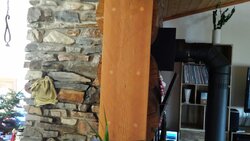I replaced an old stove on the upper level of my house with a BK Sirocco 20 back at the end of October, right before rainy season in my area.
A couple weeks later we noticed liquid creosote seeping from the from between the rocks the chimney is built from at the same level where the bottom of the flue is located. Chimney is inside the house between kitchen area and the living room. Only the top 3-4 feet is in the open air on the roof.
I was thinking that I had water coming down the top of the flue and I installed a chimney cap but that didn't help. Then the other night my downstairs stove, also a Sirocco 20 but 3 years old leaked a crap ton of liquid creosote out from all the pipe seams. I discovered that I had installed the pipes upside down. yeah I know.. whole other story.
What this made me realize, along with my smart wife and an internet search, is that the moisture leaking out my chimney on the upper level is most likely from condensation being created in the chimney from the low burns.
So, I think the way to resolve this is to install a liner in the flu space. My issue on this is that I can't figure out how to disassemble the wall thimble in order to take measurements and replace snout that would mate up to the tee.
Any thoughts on how that thing comes apart? Also, my flue liner is 11X8 oval liner that is 1" thick. Will a 6" round liner work or does it need to oval also?
A couple weeks later we noticed liquid creosote seeping from the from between the rocks the chimney is built from at the same level where the bottom of the flue is located. Chimney is inside the house between kitchen area and the living room. Only the top 3-4 feet is in the open air on the roof.
I was thinking that I had water coming down the top of the flue and I installed a chimney cap but that didn't help. Then the other night my downstairs stove, also a Sirocco 20 but 3 years old leaked a crap ton of liquid creosote out from all the pipe seams. I discovered that I had installed the pipes upside down. yeah I know.. whole other story.
What this made me realize, along with my smart wife and an internet search, is that the moisture leaking out my chimney on the upper level is most likely from condensation being created in the chimney from the low burns.
So, I think the way to resolve this is to install a liner in the flu space. My issue on this is that I can't figure out how to disassemble the wall thimble in order to take measurements and replace snout that would mate up to the tee.
Any thoughts on how that thing comes apart? Also, my flue liner is 11X8 oval liner that is 1" thick. Will a 6" round liner work or does it need to oval also?






 That wall box is mounted in the logs and goes into the bottom of the flue. The flue from there up is just clay liner, no class a pipe which is the problem I believe. It's to large for the stove to run properly from what I've researched. The flue needs to match the 6" outlet on the stove up through the chimney from what I'm finding.
That wall box is mounted in the logs and goes into the bottom of the flue. The flue from there up is just clay liner, no class a pipe which is the problem I believe. It's to large for the stove to run properly from what I've researched. The flue needs to match the 6" outlet on the stove up through the chimney from what I'm finding.
